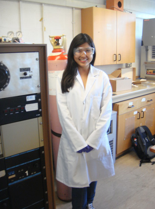
University:
Major:
Site Abroad:
Mentor(s):
Faculty Sponsor(s):
Project Title:
Project Description:
As a result of the promising discovery in February 2008 of superconductivity at relatively high temperature in an iron oxypnictide compound, LaFeAs(O,F), a rapid search for other iron-based superconductors was undertaken by the scientific community. Within one month, three different class of iron-based superconductors had been discovered. FeSe has the simplest crystal structure among the iron-based superconductors. It is a binary compound that superconducts at a critical temperature (Tc) of around 10 K, but if half of the Se atoms are substituted with Te atoms, the Tc will increase to around 15 K. To understand the effect of this chemical doping, this project has involved developing processing strategies for fabricating pseudo-single-crystalline FeSe1-xTex thin films on single-crystal substrates. Thin films have been grown using an rf-sputtering technique where atoms from a target with the desired composition are ejected into a single-crystal MgO substrate via energy transfer from a plasma. Because chemical doping affects the Tc, two targets have been made for comparison; the first target with the composition of Fe0.75Se0.2Te0.8 and the second with Fe0.85Se0.5Te0.5. Since sputtering does not guarantee that the produced thin film will have the same composition as the target, several microanalysis and characterisation techniques like EDX (Energy-Dispersive X-ray Spectroscopy), XPS (X-ray Photoelectron spectroscopy), and XRF (X-ray Fluorescence) have been performed to analyze and quantify the composition of the thin films. XRD (X-ray Diffraction) is also carried out to assess the crytallographic structure and crystallographic alignment of the films. In addition, AFM (Atomic Force Spectroscopy) has been used to image the topography and local mechanical properties of the surface of the thin films.
